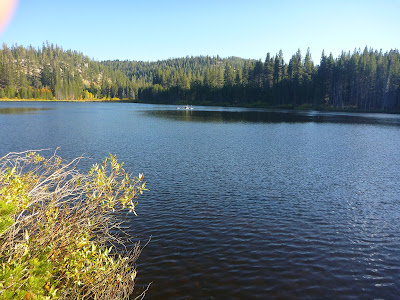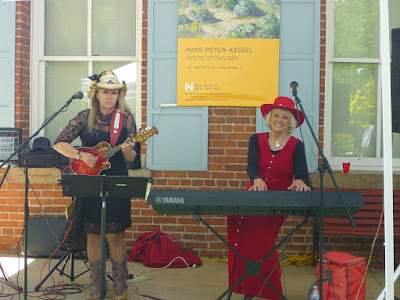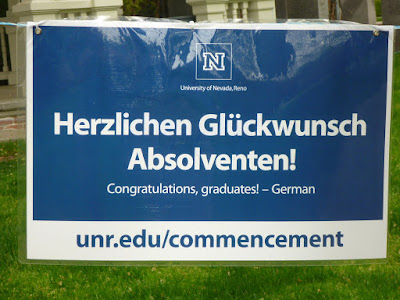The art exhibition “
Hans Meyer-Kassel: Artist of Nevada” will be on view at the
Nevada Museum of Art (
NMA) in
Reno from February 24 through September 2, 2018. Over seventy paintings, drawings and artifacts from private and institutional collections will be presented. This is going to be the first comprehensive survey of the
late-Imressionist artist who
portrayed everything from dignities to ships and glaciers. Visitors will be inspired by Meyer-Kassel's love for
northern Nevada expressed on canvases capturing scenes and landscapes of Reno-Tahoe, Pyramid Lake, Walker Lake and the Ruby Mountains. The show also includes some of his artwork from Germany, Norway and New York.
 |
| Panel partition of a replication of a Meyer-Kassel painting at NMA entrance |
About Hans Meyer-Kassel
Born as
Hans Meyer in
Kassel,
Germany, on March 8, 1872, Meyer immigrated to the United States in the early 1920s and moved to
Nevada in the mid-1930s. Here, he died in northern Nevada's
Genoa on August 30, 1952.
Hans Meyer began his career as a painter of portraits, landscapes and still lifes in Kassel and Munich. Meyer's encounter with prominent European dignitaries, who he painted, and his growing artistic reputation caused his native
Hessian city of Kassel to grant him the honor of appending the city's name to his own. Such, Meyer's common name—“Hans” and “Meyer” belong to the most frequent first and last names, respectively, in Germany—became a distinctive
moniker:
Hans Meyer-Kassel. The writing
Meyer-Cassel, using an older spelling of the
city name (see “
Fascinated by the word Kassel”), can also be found. Since the 1950s Kassel is known for the Documenta, a contemporary art event taking place every five years and populating the cityscape with sculptures such as
Frame Construction and
Man Walking to the Sky.
Between his times in Germany and Nevada, Hans Meyer-Kassel enjoyed sceneries and success on
both sites of the Atlantic Ocean. My favorite episode in Meyer-Kassel's life is his artist-style exploration of Iceland and
Norway (including the Lofoten Islands and remote Spitzbergen), where he painted
harbor towns,
floating ice and
glaciers. In 1931, Meyer-Kassel had a one-person exhibition of his artwork at the Brooklyn Museum of Art. During the last 16 years of his life, his terrain for impressionistic views was the
American West, including the landscape of northern Nevada between the Ruby Mountains and the Carson Range.
Monument Dedication in Genoa
A recent newsletter of the Nevada Museum of art announces a special event on Saturday, May 19, at 1 pm, during which a
permanent memorial to Hans Meyer-Kassel, and his beloved wife
Maria, on the grounds of the
Genoa Courthouse Museum in downtown Genoa is planned.
 |
| Display of books at museum bookstore |
Reference and more to explore
[1]
Hans Meyer-Kassel: Artist of Nevada. Link:
https://www.nevadaart.org/exhibition/hans-meyer-kassel-a-nevada-artist/.
[2] Jack Bacon (Editor/Publisher):
Hans Meyer-Kassel: Artist of Nevada.
Jack Bacon & Company with the Nevada Museum of Art, Reno, Nevada 2018.
[3]
Hans Meyer-Kassel.
Online Nevada Encyclopedia. Link:
http://www.onlinenevada.org/articles/hans-meyer-kassel.
[4]
Hans Meyer-Kassel.
Wikipedia (in German). Link:
https://de.wikipedia.org/wiki/Hans_Meyer-Kassel.





 Also, the single-lane Ash Canyon Road, which was closed throughout most of the year 2017 after suffering slides and wash-outs, is again open for public use, including four-wheel vehicles. The steep, five-mile long road starts at the end of Winnie Lane in Carson City. Passing the water tanks and the Ash Canyon Trailhead (Ash To Kings Trail connecting with Upper Waterfall Loop), the road winds uphill, westward through a steep V-shaped canyon. Past a switchback the road continues eastward with views of Carson City and sonns bends left to traverse a more densely forested area to the Hobart Reservoir parking lot.
Also, the single-lane Ash Canyon Road, which was closed throughout most of the year 2017 after suffering slides and wash-outs, is again open for public use, including four-wheel vehicles. The steep, five-mile long road starts at the end of Winnie Lane in Carson City. Passing the water tanks and the Ash Canyon Trailhead (Ash To Kings Trail connecting with Upper Waterfall Loop), the road winds uphill, westward through a steep V-shaped canyon. Past a switchback the road continues eastward with views of Carson City and sonns bends left to traverse a more densely forested area to the Hobart Reservoir parking lot.














 To watch rodeo competitions, bull riding, saddle bronc and bareback riding, steer wrestling and other perfomances you need to schedule ahead for a visit at the Reno-Sparks Livestock Events Center. During the parade, lasso-swinging boys and girls were trying to get the spectators in rodeo mood.
To watch rodeo competitions, bull riding, saddle bronc and bareback riding, steer wrestling and other perfomances you need to schedule ahead for a visit at the Reno-Sparks Livestock Events Center. During the parade, lasso-swinging boys and girls were trying to get the spectators in rodeo mood.










 The typical training is a five to ten minute rattlesnake parkour. The dog is guided to places with rattlesnake smell and also to a site with a relatively calm, yet rattling snake. That snake should have gone through veterinary work before put on site where it is handled by a trained person. Although highly unexpected, an actual bite caused by a worked-on snake would be a dry bite.
The typical training is a five to ten minute rattlesnake parkour. The dog is guided to places with rattlesnake smell and also to a site with a relatively calm, yet rattling snake. That snake should have gone through veterinary work before put on site where it is handled by a trained person. Although highly unexpected, an actual bite caused by a worked-on snake would be a dry bite. 






